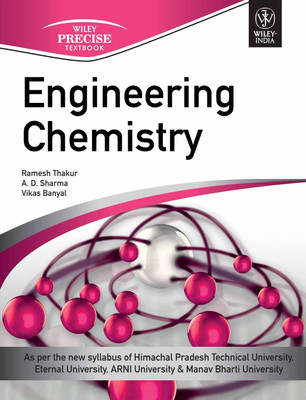Engineering Chemistry for Hptu(English, Undefined, Thakur Ramesh)
Quick Overview
Product Price Comparison
The book aims to impart in-depth knowledge of the subject and highlight the role of chemistry in the field of engineering. The lucid explanation of the topics will help students understand the fundamental concepts and apply them to design engineering materials and solve problems related to them. An attempt has been made to logically correlate the topic with its application. The book deals with basic principles of various branches of chemistry that is physical, inorganic, and analytical and extends the application of concepts to polymer, fuel and material chemistry. Other topics include photochemistry, water and its treatment and corrosion and its control. The chapter for each topic begins with clearly defined learning objectives, followed by introduction of subtopics, their precise and adequate explanation supported with ample illustrations and diagrams. Solved examples are given at the end of relevant subtopics to strengthen the concepts. The chapters conclude with a set of review and practice questions. About The Author Dr. Ramesh Thakur is Head of Department of Chemistry Department at Lovely Professional University in Jalandhar, Punjab. Dr. A. D. Sharma is Assistant Professor of Department of Chemistry at J.N. Government Engineering College in Sundernagar, Himachal Pradesh. Vikas Banyal is Assistant Professor of Department of Chemistry at MIT college of Engineering and Management in Bani, District Hamirpur, Himachal Pradesh. Table Of Contents 1. Chemical Bonding 1.1 Ionic Bond 1.2 Covalent Bond 1.3 Coordinate or Dative Bond 1.4 Quantum Theory of Chemical Bonding 1.5 Valence Bond Theory 1.6 Molecular Orbital Theory 1.7 Effective Nuclear Charge 1.8 Metallic Bond 1.9 Hydrogen Bond 1.10 van der Waals Forces 2. Thermodynamics and Chemical Equilibrium 2.1 Some Important Terms in Thermodynamics 2.2 The First Law of Thermodynamics 2.3 Enthalpy or Heat Content 2.4 The Second Law of Thermodynamics 2.5 Entropy 2.6 The Third Law of Thermodynamics 2.7 Free Energy 2.8 Thermodynamic Criteria for Equilibrium 2.9 Physical Equilibrium 2.10 Chemical Equilibrium 2.11 Ionic Equilibrium 3. Chemical Kinetics 3.1 Rate of Reaction 3.2 Order and Molecularity 3.3 Integrated Rate Equations and Half Lives 3.4 Pseudo-Order Reactions 3.5 Complex Reactions 3.6 Temperature Dependence of Rate of Reactions 3.7 Theory of Reaction Rates 4. Phase Rule 4.1 Definition of Terms 4.2 Phase Rule 4.3 Phase Diagram 4.4 One-Component Systems 4.5 Two-Component Systems 4.6 Thermal Analysis 5. Electrochemistry 5.1 Electrical Conductance 5.2 Electrochemical Cells 5.3 Electrode Potential 5.4 Galvanic Cells 5.5 Nernst Equation 5.6 Measurement of EMF of the Cell 5.7 Reference Electrodes 5.8 Single Electrode Potential 5.9 Types of Electrodes 5.10 Glass Electrode 5.11 Concentration Cells 5.12 Batteries 5.13 Classical Batteries 5.14 Modern Batteries 5.15 Fuel Cells 6. Chemical Methods of Analysis 6.1 Physical Analysis 6.2 Chemical Analysis 6.3 Volumetric (Titrimetric) Analysis 6.4 Neutralization Titrations (Acid-Base Titrations) 6.5 Redox Titrations 6.6 Complexometric Titrations 6.7 Precipitation Titrations 6.8 Gravimetric Analysis 7. Instrumental Methods of Analysis 7.1 Electroanalytical Methods 7.2 Electromagnetic Radiation 7.3 Molecular Spectroscopy 7.4 Basic Spectroscopy Instrumentation 7.5 Infrared Spectroscopy 7.6 NMR Spectroscopy 7.7 UV-Visible Spectroscopy 7.8 Mass Spectroscopy 7.9 Chromatography 8. Photochemistry 8.1 Quantum Nature of Matter and Light 8.2 Photochemical Transformations 8.3 Molecular Excitation 8.4 Physical Deactivation of Excited State 8.5 Fluorescence and Phosphorescence 8.6 Applications of Photochemistry 9. Water and its Treatment 9.1 Sources of Water 9.2 Impurities in Water 9.3 Hardness of water 9.4 Determination of Hardness of Water 9.5 Alkalinity of Water 9.6 Disadvantages of Hard Water 9.7 Potable Water 9.8 Boiler Feed Water 9.9 Techniques for Water Softening 9.10 Sewage 10. Corrosion and its Control 10.1 Corrosion in Metals and Alloys 10.2 Corrosion Cell 10.3 Types of Corrosion 10.4 Types of Electrochemical Corrosion 10.5 Other Types of Corrosion 10.6 Factors Influencing Rate of Corrosion 10.7 Corrosion Control Methods 10.8 Protective Coatings 10.9 Metal Finishing 10.10 Electroplating Process 10.11 Effect of Plating Variables on Nature of Electrodeposit 10.12 Surface Preparation 10.13 Electroplating of Chromium and Silver 10.14 Electroless Plating 11. Fuels 11.1 Classifications of Fuels 11.2 Calorific Value 11.3 Determination of Calorific Value 11.4 Combustion 11.5 Solid Fuels - Coal 11.6 Proximate and Ultimate Analyses of Coal 11.7 Coke 11.8 Biofuels 11.9 Liquid fuels - Petroleum 11.10 Power Alcohol and Synthetic Petrol 11.11 Gaseous Fuels 12. Polymers and Composite Materials 12.1 Some Important Terms and Definitions 12.2 Classification of Polymers 12.3 Types of Polymerization 12.4 Mechanism of Addition Polymerization 12.5 Polymerization Techniques 12.6 Molecular Weights of Polymers 12.7 Structure-Property Relationship of Polymers 12.8 Plastics 12.9 Some Important Commercial Thermoplastics 12.10 Some Important Commercial Thermosetting Resins 12.11 Elastomers (Rubbers) 12.12 Some Important Synthetic Rubbers 12.13 Fibers 12.14 Some Important Synthetic and Semi-synthetic Fibers 12.15 Composites 12.16 Adhesives 12.17 Conducting Polymers 12.18 Semiconducting Polymers 12.19 Natural Polymers (Biopolymers) 12.20 Ion Exchange Resins 12.21 Biodegradable Polymers 13. Lubricants 13.1 Principle of Lubrication 13.2 Mechanism of Lubrication 13.3 Classification of Lubricants 13.4 Properties of Lubricants and their Measurement 13.5 Greases 13.6 Selection of Lubricants


